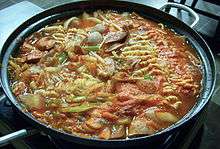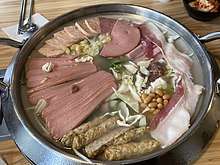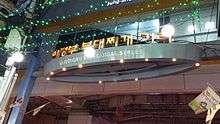Budae-jjigae
Budae-jjigae (부대찌개; literally "army base stew") or spicy sausage stew is a type of jjigae (stew), made with ham, sausage, spam, baked beans, kimchi and gochujang.[1] The dish was created shortly after the armistice that ended the Korean War, using the scrounged or smuggled surplus foods from the U. S. army bases.[2] Although the dish was born in the period of post-war impoverishment, it continued to be popular during the period of rapid growth, and is still popular today. There are many restaurants specializing in budae-jjigae; the most famous ones on the budae-jjigae street in Uijeongbu, where the dish was first made. The dish is now a popular anju (accompaniment to alcoholic drinks) and a lunch item in college neighborhoods.[3][2]
 | |
| Alternative names | Sausage stew |
|---|---|
| Type | Jjigae |
| Place of origin | South Korea (with American influence) |
| Region or state | Uijeongbu |
| Associated national cuisine | Korean cuisine |
| Created by | Ho Gi-suk |
| Invented | 1954 |
| Main ingredients | Ham, hot dogs, Spam, baked beans, kimchi, gochujang |
| Korean name | |
| Hangul | 부대찌개 |
|---|---|
| Hanja | 部隊-- |
| Revised Romanization | budae-jjigae |
| McCune–Reischauer | pudae-tchigae |
| IPA | [pu.dɛ.t͈ɕi.ɡɛ] |

Etymology
Budae (부대; 部隊) is a military unit, often a "troop". As a troop's camp is also called budae, the word gun budae (군부대; 軍部隊; "military camp") is often used to refer to military camps in general, and migun budae (미군부대; 美軍部隊; "U.S. military camp") to the U.S. military bases. Jjigae (찌개), often translated as "stew", means a soup thicker than guk (soup).
History

After the Korean War, food was scarce in South Korea. People dwelling around U. S. army bases, in the Uijeongbu, Pyeongtaek, and Munsan areas made use of surplus foods from army bases, commonly processed meat products, collectively known as budae-gogi (부대고기; "army base meat"), such as ham, hot dogs, and Spam, along with canned baked beans.[4][5] It is said that budae-jjigae begun as a buttery stir-fried snack made of sausages, ham, cabbages and onions to accompany makgeolli (cloudy rice wine), but later on, anchovy broth flavored with gochujang and kimchi was added to create the stew that is enjoyed today.[4] The ingredients were often scrounged or smuggled through a black market, as American products were not legally accessible to Koreans.[2]
Budae-jjigae is still popular in South Korea. Common ingredients now include: baked beans Vienna sausage, bacon, tofu, pork, ground beef, instant noodles, macaroni, tteok (rice cake), American cheese, mozzarella, water-dropworts, scallions, chili peppers, garlic, mushrooms and other vegetables in season.[6] The city of Uijeongbu, which is bordered by Seoul to the south and has many army bases, is famous for its budae-jjigae. In the late 20th century, the city of Uijeongbu stipulated that the dish be referred to as Uijeongbu-jjigae to remove the military or war-time connotation in the name, though not many restaurants follow this guideline. Some restaurants have begun calling their product Uijeongbu-budae-jjigae. There is also what locals refer to as "Uijeongbu Budae-jjigae Street" where there is a high concentration of budae-jjigae restaurants.[7][8]
Johnsontang
A form of Budae jjigae developed around a U.S. military unit stationed in Yongsan-gu, Seoul, is called Johnsontang (존슨탕; "Johnson soup").[9] It is named after United States President Lyndon B. Johnson, who is said to have raved about the taste of the dish during his visit to Korea.[10]
See also
References
- National Institute of Korean Language (30 July 2014). "주요 한식명(200개) 로마자 표기 및 번역(영, 중, 일) 표준안" (PDF) (in Korean). Retrieved 19 February 2017. Lay summary – National Institute of Korean Language.
- Cho, Grace M. (22 August 2014). "Eating military base stew". Contexts. Retrieved 29 May 2017.
- West, Da-Hae (19 June 2016). "Gettin' jjigae with spam: a US/South Korean fusion". The Guardian. Retrieved 29 May 2017.
- "budae-jjigae" 부대찌개. Korean Food Foundation. Retrieved 29 May 2017.
- Bamman, Mattie John (3 March 2017). "The Korean Comfort Food at the Intersection of War and Peace". Eater. Vox. Retrieved 29 May 2017.
- Lee, Hyo-won (24 June 2010). "Life post-June 25, 1950". The Korea Times. Retrieved 1 April 2013.
- "Uijeongbu restaurant owners take pride in army base stew". The Korea Times. 26 June 2012. Retrieved 1 April 2013.
- Kim, Violet (6 April 2012). "Food map: Eat your way around Korea". CNN. Retrieved 12 April 2012.
- "존슨탕을 아시나요? 미군부대 앞서 시작된 부대찌개 사촌". TV리포트. Retrieved 2019-04-03.
- Lee, Yong-sung; Kim, Hyun-chul (30 December 2004). "From Trash to Delicious Treasure". The Korea Times. Archived from the original on 13 January 2006. Retrieved 1 April 2012.